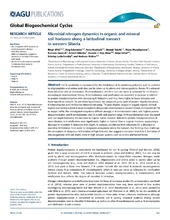| dc.contributor.author | Wild, Birgit | |
| dc.contributor.author | Schnecker, Jörg | |
| dc.contributor.author | Knoltsch, Anna | |
| dc.contributor.author | Takriti, Mounir | |
| dc.contributor.author | Mooshammer, Maria | |
| dc.contributor.author | Gentsch, Norman | |
| dc.contributor.author | Mikutta, Robert | |
| dc.contributor.author | Alves, Ricardo J. Eloy | |
| dc.contributor.author | Gittel, Antje | |
| dc.contributor.author | Lashchinskiy, Nikolay | |
| dc.contributor.author | Richter, Andreas | |
| dc.date.accessioned | 2016-01-14T09:22:42Z | |
| dc.date.available | 2016-01-14T09:22:42Z | |
| dc.date.issued | 2015-05-12 | |
| dc.Published | Global Biogeochemical Cycles 2015, 29(5):567-582 | eng |
| dc.identifier.issn | 0886-6236 | en_US |
| dc.identifier.uri | http://hdl.handle.net/1956/10956 | |
| dc.description.abstract | Soil N availability is constrained by the breakdown of N-containing polymers such as proteins to oligopeptides and amino acids that can be taken up by plants and microorganisms. Excess N is released from microbial cells as ammonium (N mineralization), which in turn can serve as substrate for nitrification. According to stoichiometric theory, N mineralization and nitrification are expected to increase in relation to protein depolymerization with decreasing N limitation, and thus from higher to lower latitudes and from topsoils to subsoils. To test these hypotheses, we compared gross rates of protein depolymerization, N mineralization and nitrification (determined using 15N pool dilution assays) in organic topsoil, mineral topsoil, and mineral subsoil of seven ecosystems along a latitudinal transect in western Siberia, from tundra (67°N) to steppe (54°N). The investigated ecosystems differed strongly in N transformation rates, with highest protein depolymerization and N mineralization rates in middle and southern taiga. All N transformation rates decreased with soil depth following the decrease in organic matter content. Related to protein depolymerization, N mineralization and nitrification were significantly higher in mineral than in organic horizons, supporting a decrease in microbial N limitation with depth. In contrast, we did not find indications for a decrease in microbial N limitation from arctic to temperate ecosystems along the transect. Our findings thus challenge the perception of ubiquitous N limitation at high latitudes, but suggest a transition from N to C limitation of microorganisms with soil depth, even in high-latitude systems such as tundra and boreal forest. | en_US |
| dc.language.iso | eng | eng |
| dc.publisher | The American Chemical Society (ACS) Publications | en_US |
| dc.rights | Attribution CC BY 4.0 | eng |
| dc.rights.uri | http://creativecommons.org/licenses/by/4.0 | eng |
| dc.subject | tundra | eng |
| dc.subject | Permafrost | eng |
| dc.subject | boreal forest | eng |
| dc.subject | protein depolymerization | eng |
| dc.title | Microbial nitrogen dynamics in organic and mineral soil horizons along a latitudinal transect in western Siberia | en_US |
| dc.type | Peer reviewed | |
| dc.type | Journal article | |
| dc.date.updated | 2015-12-29T14:31:41Z | |
| dc.description.version | publishedVersion | en_US |
| dc.rights.holder | Copyright 2015 The Authors | en_US |
| dc.identifier.doi | https://doi.org/10.1002/2015gb005084 | |
| dc.identifier.cristin | 1262923 | |
| dc.subject.nsi | VDP::Matematikk og naturvitenskap: 400::Basale biofag: 470::Generell mikrobiologi: 472 | |
| dc.subject.nsi | VDP::Mathematics and natural scienses: 400::Basic biosciences: 470::General microbiology: 472 | |
| dc.subject.nsi | VDP::Matematikk og Naturvitenskap: 400 | en_US |

